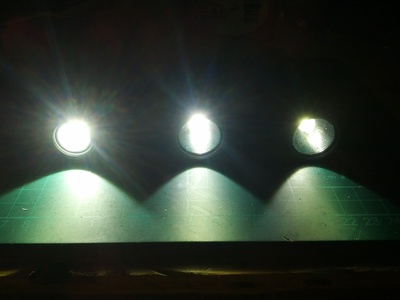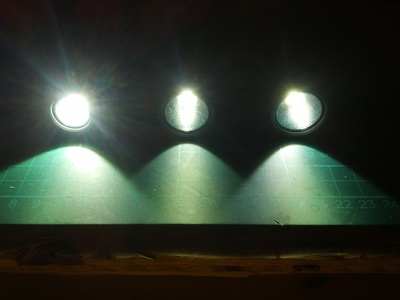
53 Users Online
![]() Attach
|
Attach
|
![]() Edit
|
Edit
|
![]() Revisions
Revisions
![]() Related Content
Related Content
We used a cutting mat to line up the flashlights and used its texture surface to observe the light reflection intensity. The ambient light is turned off to eliminate any possibility of its effect on the results.
In the first test, we lined up the Ozark Trail flashlight with alkaline battery on the left, the Enercell flashlight with alkaline battery in the middle, and the Enercell flashlight with NiMH battery on the right. The result is shown in the photo below. You can see that the NiMH flashlight is slightly dimmer from both the light source and the mat reflection.

In the second test, we wanted to eliminate the possibility that the middle flashlight being closest to the camera having an effect on the first test result. We swapped the positions of the two Enercell flashlights. The result is shown below. As you can see this test proves conclusively that the Enercell LED Flashlight is effected by battery voltage.

In the third test, we swapped the batteries in the Ozark Trail Flashlight to NiMH batteries. The result is shown below. This third test is not as conclusive. It seems battery change did not make a difference on the Ozark Trail flashlight.

The third test is not conclusive because of three reasons: 1) we don't have two Ozark Trail Flashlight to test side-by-side; and 2) the Google Samsung Galaxy Nexus does not allow manual adjustment to exposure settings; and 3) the camera is not fixed on a tripod.
To create a conclusive test, we used two old and half-charged AA NiCd batteries in the Ozark Trail Flashlight. And we immediately see a huge difference in light output. With the NiCd batteries, the flashlight is noticeably dimmer than the fully-charged AA NiMH batteries.
LED flashlights are effected by battery voltage. If the flashlight brightness if highly critical to your purpose, you'll always want to have fresh Alkaline batteries on hand.
![]() Attach
|
Attach
|
![]() Edit
|
Edit
|
![]() Revisions
Revisions
![]() Related Content
Related Content